Today, I'm taking you on a culinary journey to the heart of Ireland, where we will unlock the secrets behind making the perfect Irish Brown Soda Bread with Molasses. This traditional Irish brown bread is an easy soda bread recipe made with whole wheat flour, oats, and molasses.
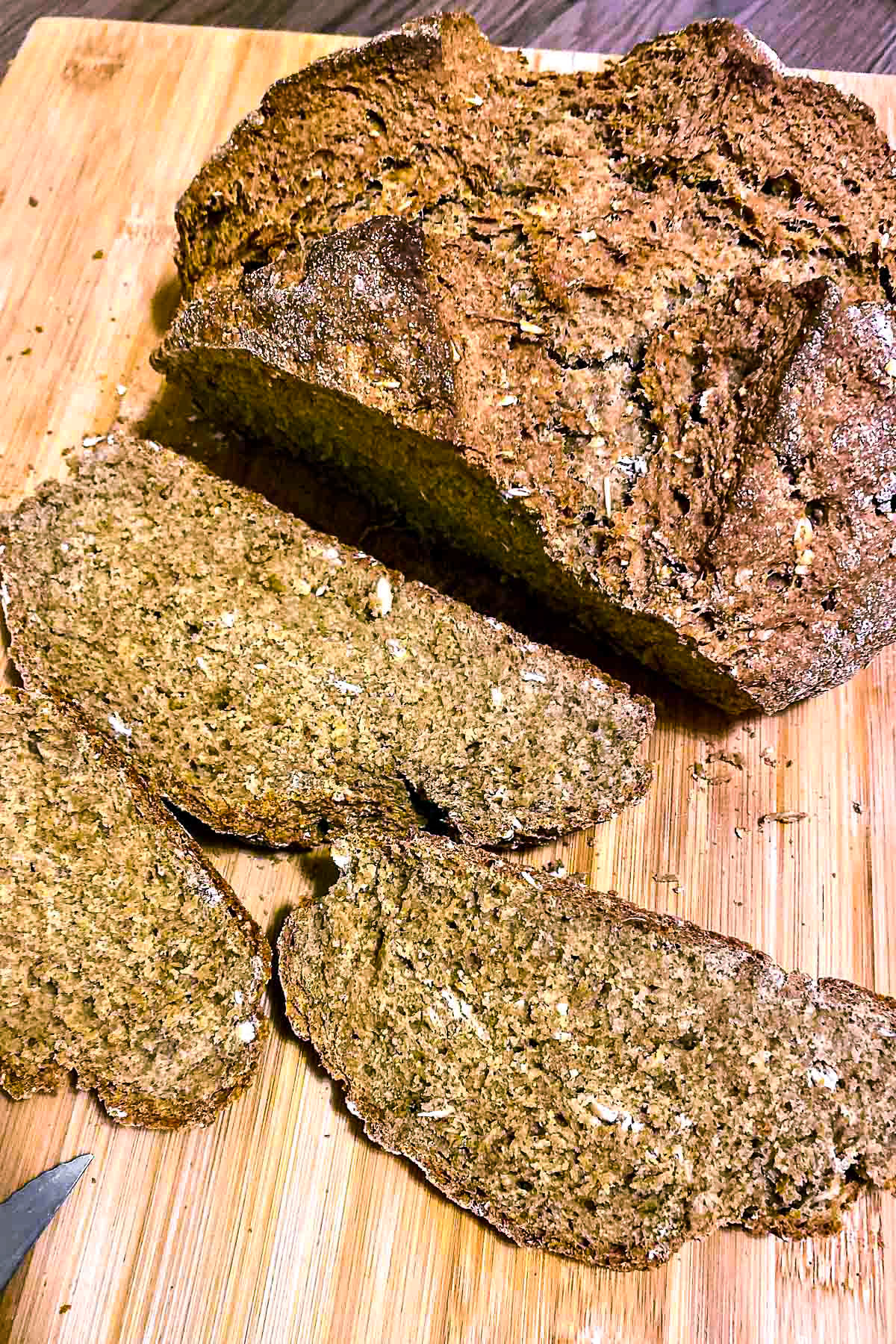
If you are looking for an authentic recipe that will complement your St. Patrick's Day dinner, this recipe is for you.
Jump to:
On my first trip to Dublin, Ireland, I immediately fell for the city's charm, the welcoming climate, and, notably, the outstanding variety of breads, a staple love in Ireland as in many European countries.
From classic white soda to varieties enriched with beer, molasses (or "treacle," as the locals say), oats, or seeds, each bread was a wonderful discovery that intensified my passion for baking.
I came back home ready to try some of these breads. If you are shy about making bread at home, you are not alone. Making bread, especially with yeast, could be pretty intimidating. For that reason, starting with simple bread, like Irish soda bread, might inspire you to try some more diverse recipes.
You can try this activity with children from a young age, even if it means a lot of mess in the kitchen afterward. I encourage you to take the time to enjoy the simplest pleasures of baking an apple cake or soda bread, connecting with the generations of bakers who have cherished these recipes before us.
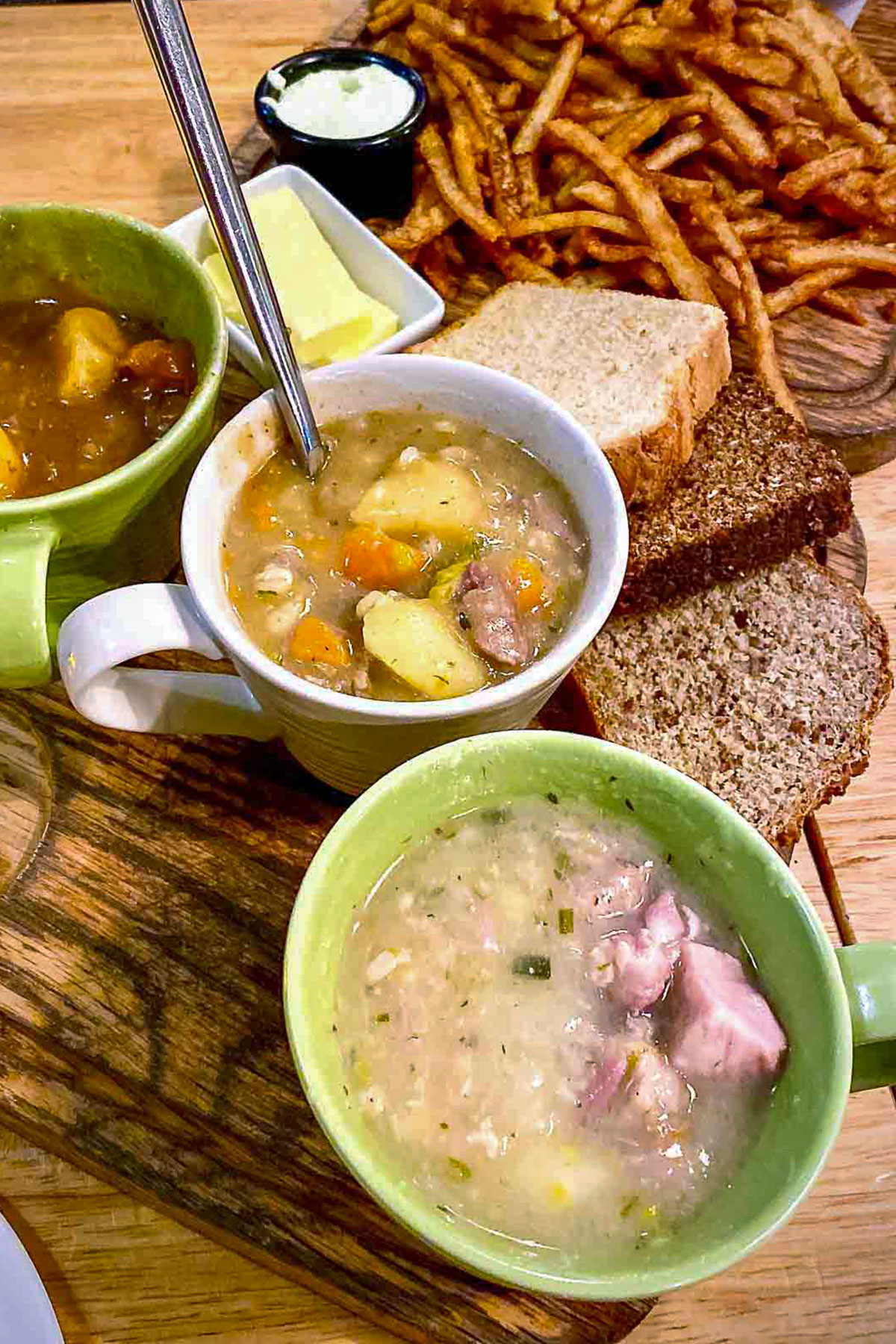
What is soda bread
Irish soda bread, a staple in Ireland, is a simple yet delicious bread made with flour, buttermilk, and baking soda, often referred to as "quick bread" in the US. Traditionally baked over an open fire, it's enjoyed hot or cold with butter and jam, a common sight at breakfast and tea times across Ireland.
This tradition reflects Ireland's rich baking heritage, where bread is hearty and filling. In the US, variations include raisins, dried currants, and caraway seeds for special occasions, additions that would have been luxuries in historical Ireland.
The traditional methods of baking soda bread, like shaping it round, flour dusting, and cutting a cross on top, have endured through centuries, adapting from iron skillets and Dutch ovens to modern ovens for consistently perfect loaves.
Why You'll Love This Irish Brown Soda Bread with Molasses
- Quick and Easy: No yeast, no proofing, and no fuss! This recipe comes together in about an hour.
- Wholesome Ingredients: Packed with whole grains and fiber, it's bread you can feel good about.
- Versatile: Perfect for breakfast, alongside a hearty stew, or as a snack with butter and jam.
- Rich in Flavor: The molasses adds a unique, rich sweetness that complements the nuttiness of the whole wheat and oats.
Home Cook's Notes On Ingredients
- All-Purpose Flour & Whole Wheat Flour: These provide the structure. You can substitute some of the all-purpose flour with more whole wheat for an even heartier loaf. A half-and-half mixture of whole wheat flour and white flour works the best, but hundreds of recipes out there also call for rye, oats or spelt, and even beer.
- Rolled Oats: Adds texture and a slight nuttiness. Quick oats can be used in a pinch, but they'll alter the texture slightly.
- Salt & Baking Soda: Essential for flavor and the chemical reaction that helps the bread rise.
- Buttermilk: The acidity reacts with baking soda for leavening and adds a mild tanginess. No buttermilk? Mix regular milk with a tablespoon of lemon juice or vinegar.
- Molasses (Black Treacle): Offers deep, complex sweetness and moisture. Honey or maple syrup are possible substitutes, but the flavor will be different.
From The Kitchen
Step 1. Prep: Preheat your oven to 450F.
Step 2. Mix Dry Ingredients. Whisk together your flours, oats, salt, and baking soda.
Step 3. Add Wet Ingredients. Create a well for the buttermilk and molasses. Using a fork, stir the liquid, gradually bringing the flour in from around the edge.

Step 4. Shape and Bake: Form your dough, cut a cross on top, and bake until golden and hollow-sounding.
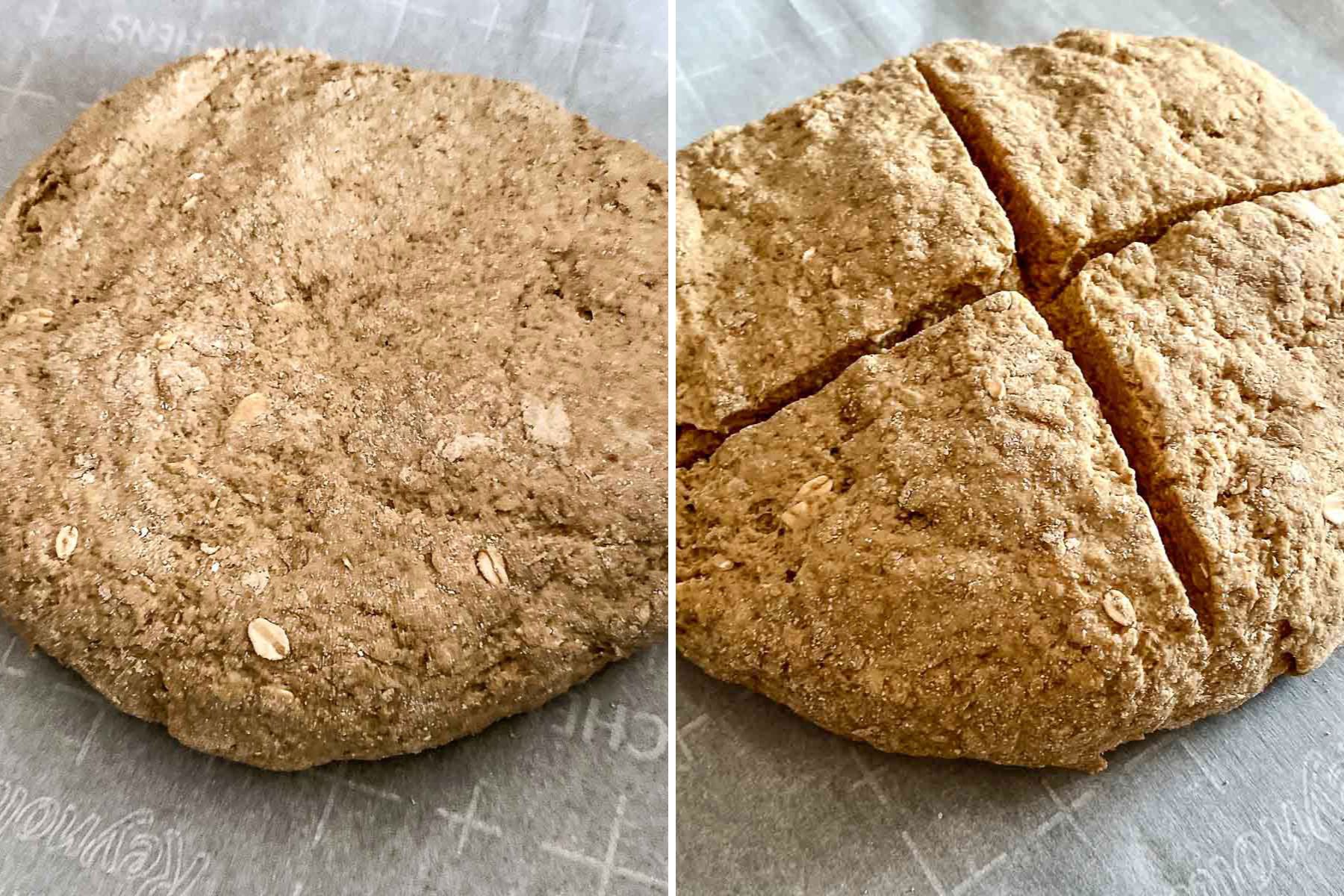

Expert tip
How to handle soda bread dough: Do not be tempted to knead the soda bread made with baking powder or baking soda the same way you would knead yeast bread. Too much handling causes the bread to toughen.
The process should not take more than a few minutes from the time you add the buttermilk to the time you put it in the oven- any longer, and the action of the baking soda is lost.
What To Serve This Bread With
This bread is a chameleon on the table. Serve it warm with a slather of butter for breakfast, alongside your favorite hearty soups or delicious stews for dinner, or with cheese and fruit for a satisfying snack.

Recipe Faqs
Traditionally, a deep cross is cut into the top of the soda bread, giving it its distinctive appearance. Mothers used to tell their children that the cross allowed the fairies to escape.
I recently caught an Irish cooking show on TV where the baker, while crafting soda bread alongside Paul Hollywood, explained the tradition of cutting a cross on top, just as she was doing it herself.
The real purpose of the cross is actually to allow the steam to escape during baking, producing a lighter textured bread.
I recently gave it a try and, let me tell you, waiting for it to cool was a battle I lost. Slathering it with butter, I watched it melt and couldn't resist. It was bliss, no guilt attached! Serve it with good Irish butter and jam or honey next to a cup of tea/coffee.
A common reason for dense soda bread is overmixing the dough. It's important to gently combine the wet and dry ingredients just until they start to form a ball. Overworking the dough activates the gluten too much, making the bread tough rather than light and airy
Absolutely, Irish soda bread is delicious when warm, offering a crisp crust and soft, tender inside. It's often served with butter, which melts beautifully on the warm bread.
I actually saw three types of bread served as a starter at this Gallagher's Boxty House restaurant in Dublin. I mean, people are ordering slices of warm bread and a bunch of butter and eating them while drinking beer! How cool is that!
I think we should adopt this tradition as long as we make these breads from scratch with good, honest ingredients. You should try it for St. Patrick's Day!
If your soda bread turns out dry, it might have been baked too long or is a day or two old. To prevent this, keep an eye on the baking time and store the bread properly to maintain its moisture.
Are you also interested in baking more with buttermilk and baking soda? This article about baking with buttermilk will just help you do that. And finally, if you liked this recipe you should also try:
- Beer Bread
- Easy Savory Cheese Bread
- 25 Savory Quick Bread Recipes
- 32 Easy Recipes For St. Patrick's Day
Happy baking!
More Bread Recipes To Love
📖 Recipe

Irish Brown Soda Bread With Molasses
Ingredients
- 2 cups all purpose flour plus extra for dusting
- 2 cups whole wheat flour
- ½ cup rolled oats
- 1 ½ teaspoons salt
- 1 teaspoon baking soda
- 1 ⅔ cup buttermilk
- 2 tablespoons molasses black treacle
Instructions
- Preheat the oven to 450F/230C. Line a baking tray with parchment paper and set aside.
- In a large bowl, combine the flours, oats, salt and baking soda. Mix throughly.
- Make a well in the middle of the flour and pour in the buttermilk and molasses.
- Using a fork, stir the liquid, gradually bringing the flour in from around the edge.
- With floured hands lightly knead to a soft dough.
- Shape the dough into a round and place it on the parchment paper. Press the dough flat about 2 inches/5cm thick. Use a sharp knife with a long blade to cut a deep cross on the top.
- Bake in the oven for 15 minutes, then reduce the oven temperature to 400F/200C.
- Continue baking the bread for another 20-25 minutes or until the base of the bread sounds hollow when tapped.
- Transfer to a wire rack and allow it to cool slightly. Serve warm.
Video
Notes
Nutrition
Published originally on February 14, 2020 and republished in March 2024.

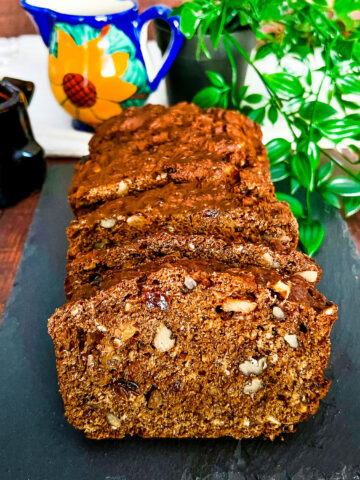





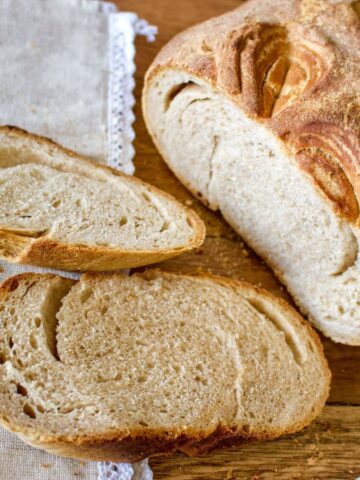

Joyce says
For 30 years I have made either Irish Soda bread or a Molasses Oat bread. I LOVE this recipe because it merges my two favorites together. I did make a couple of modifications. I reduced the All Purpose flour to 1 cup along with 1 cup of Dark Rye flour and also added 1/4 cup of ground Flax seed. Thank you so much for sharing!
Deb Murray says
I made a traditional Irish soda bread for St. Patrick's day that came out beautifully. I really wanted to try one with molasses, so I chose this one. Right off, I noticed that the leavening agent seemed deficient. I was right. I'm sorely disappointed in the poor outcome. I MAY try this again with the proper amount of leavening.
The Bossy Kitchen says
Hi Deb,
With all due respect, the amount of baking soda in this recipe is the right one. You got me intrigued, so I did some research, and this is what I found out:
We have 4 cups of flour in this recipe (2 cups all-purpose flour and 2 cups whole wheat). According to science, 1 cup of flour needs 1/4 teaspoon of baking soda. So, if we have 4 cups of flour, we need 1 teaspoon of baking soda in total. (exactly what the recipe calls for).
Now, how much do we need for 1 cup of buttermilk? We need 1/2 teaspoon of baking soda. This recipe calls for 1 2/3 cups of buttermilk, so basically, we would need less than a teaspoon, right? We do have a full teaspoon though, which is plenty.
Also, molasses acts as a leavening ingredient also, as it is quite acidic. It works beautifully with baking soda helping the dough rise.
However, you need to remember that whole-wheat flour makes your baked goods denser and a lot heavier than those made with just all-purpose flour, and this is why you probably think that the recipe needs more baking soda.
As you do not describe exactly the "poor outcome", it is hard for me to figure out what went wrong, so please write back and tell me more about what happened. Thank you.